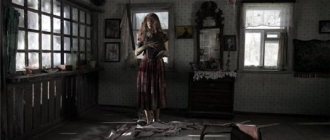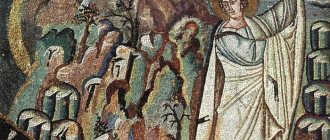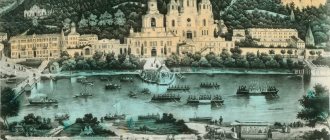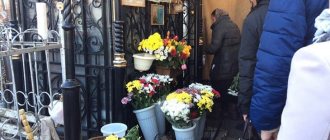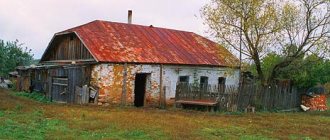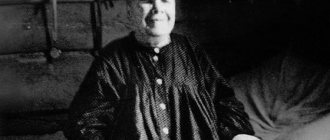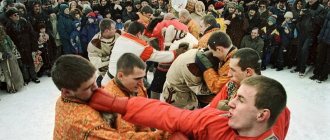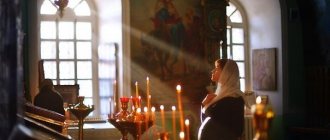Moscow, 07/24/2021, 02:48:02, editorial office of FTimes.ru, author Zoya Zharkova.
On April 28, the Rossiya 1 channel showed Arkady Mamontov’s documentary “Blessed Matrona.”
Blind, immobile, persecuted - she became a beloved saint for the Orthodox. Hundreds of thousands of people still come to Blessed Matrona of Moscow today.
The documentary film by Arkady Mamontov “Blessed Matrona” is a film about the earthly life and service of God of a blind, immobile, persecuted woman who became a beloved saint of many believers, whose memory is still honored today.
It would seem that her whole life should be known, but when the filmmakers began to explore her biography, the incredible was revealed. Photographs were found that had not yet been published anywhere, and amazing facts were revealed.
Where and how was the film filmed?
The authors began to explore the life of Matrona of Moscow from the moment of birth.
Matrona's life and existence were difficult. She had to endure enormous trials of weakness and blindness, but she came to terms with it and was not offended by God, saying:
"God! If so, it means good, and I have You, I will pray to You.”
Why did she, at the end of her worldly life, become even closer to so many people? Why did she become a savior, intercessor, advisor in many matters and issues? Who leads people to Matronushka, as believers affectionately call her?
It was faith in God, in his power and justice that gave and gives Matronushka the ability to heal wounds, stop illnesses and prevent misfortune.
She lovingly gave her heart to the Lord and prayed to him constantly.
The only thing she asked and asks from people is to believe in God and maintain the Orthodox faith.
The official biography says that she was born in the village of Sebino, Tula region. The filmmakers went there first.
It is believed that Matrona was born into a poor family. The parents were in poor health and had four children. Matrona was the youngest, and they wanted to give her to an orphanage.
It was not possible to verify this data in Matrona’s native village. The film crew went in search of documents in the Tula State Archives.
In the documentary, television viewers heard truthful information about the financial situation of the Nikonov family, the birth of children in their family and the birth of Matrona. She is believed to have been born in 1881.
Matrenin's house. Has it really survived, Matrona’s house?
A museum dedicated to the life of Matrona has opened in the village of Sebino - they will tell about it and about the Holy Dormition Church, the foundation of which dates back to 1694. It has a font where Matrona was baptized.
It is known that at the request of Matrona, two icons of the Mother of God “Seeking the Lost” were painted. They have survived to this day.
Pokrovsky Convent. It is here that the silver shrine with the relics of the blessed old woman Matrona of Moscow is located.
The abbess of the monastery is Mother Feofania, thanks to her Matrona was canonized. Mother very rarely meets with journalists and does not give interviews. But she made an exception for the filmmakers.
Today, everyone who wants to venerate the relics of Matrona bears gifts. Some bring food, some carry a ring, some carry earrings, but more often they bring flowers - this tradition has been observed for several years now. Everyone in line to see her knows: you have to go to Matrona with flowers. For some reason, many are sure that they must carry white bouquets and that they must be roses.
The authors of the film told what kind of flowers you should actually carry and how many there should be.
Holy Matrona of Moscow and the Pokrovsky Monastery. Video film.
Dear admirers of the Holy Blessed Matrona of Moscow!
We bring to your attention a film that is amazing in its content, after watching which the hope will ignite that the Holy Matronushka will hear us too!
And she will help us, just as she has helped more than one hundred thousand people who flock to her with faith!
Film duration: 69 minutes
With God's help, the salvation of the soul is achieved, as we know, even in the midst of a noisy world. But spiritual perfection, the acquisition of the grace of the Holy Spirit, is achieved primarily at a distance from worldly dwellings, behind the blessed walls of monasteries, in monasticism.
In the very heart of Russia, in the center of Moscow, there is a stauropegic convent in honor of the Intercession of the Blessed Virgin Mary. In the mid-90s of the last century, after many years of ruin and devastation, the Moscow monastery again became a place of monastic deeds, a place of prayer. This monastery is especially dear to the believing heart because within its walls rest the relics of the blessed Elder Matrona, an ascetic of the 20th century, glorified among the locally revered saints of the Moscow diocese. The blessed Lady of Christ shines with a special light among the great host of Russian saints standing before the Throne of God.
During the difficult years of atheistic oppression for the Church, Matronushka became a national comforter. People came to her, seeking resolution of vital issues, consolation in sorrows, learning humility, patience and active Christian love. And today the stream of people flowing to the Intercession Monastery does not dry out, with faith bringing their aspirations and prayers to the relics of the blessed old woman.
From the very early morning, as soon as the monastery gates open, people rush to the Intercession Monastery. They rush to venerate the relics of the blessed old lady Matrona. Hundreds and hundreds of thousands of Orthodox people know it today.
Matronushka, as many affectionately call her, ended her earthly life on May 2, 1952. But she didn't die. She is alive. And this is felt by everyone who comes to her and asks for intercession and intercession before the Lord, towards whom the blessed old woman has great boldness. From birth she was loved by the Lord. Matronushka is called Matronushka, chosen by God from the swaddling cloths.
Blessed Matrona, I come to you again and again with my troubles, and you greet me every time with a smile on your face. And every time you say: “Everything will be fine. Everything will work out in your life, and God will hear your prayer.” I believe and know that you pray for us all and try to help everyone with your prayer. And I remember the words spoken by blessed Matrona before her righteous death: “Everyone, everyone, come to me, and tell me as if alive about your sorrows. I will see and hear you and help you.”
Even before the transfer of the venerable remains of the blessed Elder Matrona to the Pokrovskaya monastery, Mother Superior Feofaniya and the sisters of the Intercession Monastery often went to the Danilovskoye cemetery, to her grave, prayed to her, served memorial services, and each time miraculously, through the prayers of Matronushka, they received help in what they asked for. Thus, through the grace-filled strengthening sent by the holy righteous Matrona, with the tireless prayers and labors of the abbess and sisters, the revival and improvement of the Intercession monastery is taking place.
The history of the monastery goes back to ancient times. The Tsar's Pokrovsky Monastery was founded five miles from the Moscow Kremlin by Tsar Mikhail Fedorovich. In 1635, he granted land for its construction, the ownership of which was secured by charter. However, years passed, and only 20 years later, by decree and at the expense of Tsar Alexei Mikhailovich, the monastery was built, equipped with church utensils and everything necessary. Members of the royal family visited the monastery several times.
By the beginning of the 20th century, the monastery had two churches: the Resurrection Cathedral with three altars and the Church of the Intercession of the Mother of God. Bell tower, cell buildings for monks, almshouse, outbuildings. On the western side, the churches were surrounded by a cemetery where famous clergy and high-ranking officials were buried. The monastery was surrounded by a fence.
The last abbot of the Intercession Monastery was Archimandrite Veniamin (Milov). In his diary in 1928, he writes: “The source of great anxiety was the understanding that step by step the Intercession Monastery was approaching its end. The Intercession Cathedral was closed, the cemetery chapels were demolished, and the grave monuments were buried in the ground.”
What anxiety and torment squeezed the soul with every unsuccessful attempt to defend the monastery building. To great general sorrow, in 1929 a decree was issued to close the last monastery church. Archimandrite Benjamin, together with the brethren of the monastery, was arrested and exiled to the camps. The monastery was disfigured and prayer ceased to sound within its walls for many decades.
Abbess Feofania. When I arrived for the first time on March 11, 1995, to see what the territory was like, I saw, of course, the churches were in terrible condition. So many tenants. It was hard, of course, to start and look at it. But at the same time, it was somehow joyful in my soul that it was being handed over to the monastery after all. With difficult trials, of course. The first time was, of course, very difficult. When we first entered in 1995, of course, the premises were semi-basement. There was a warehouse on the ground floor of the Intercession Church. There, one might say, there used to be a printing house, and apparently everything was neglected, everything was abandoned. On October 14 we already had a service for Intercession. The windows were covered with plywood. There was nothing. We slept on the floor. And by the Intercession we already had five sisters. When the service began, it immediately went with God's help. It was so joyful. Even now I’m not so happy about anything. It was somehow joyful. And my sisters rejoiced with me. 1-2 people came to the service on Saturday and Sunday. Of course, people gathered for Intercession from somewhere. And so, little by little, people gathered around us. After His Holiness consecrated our entire territory with a prayer service, after 2-3 days the Church of the Resurrection was vacated for us. Although there were no documents. No ruling, nothing. A month later, we issue a resolution and all buildings are transferred. After His Holiness served the first prayer service on October 13, 1996, we immediately received documents. It was only after the prayer service that everything went well for us.
His Holiness Vladyka Alexy II took fatherly care of his many children and the reviving monastery. In 1998, on the Feast of Praise of the Mother of God, His Holiness the Patriarch served the Liturgy for the first time in the monastery and blessed the crosses, which were subsequently installed on the domes of the Intercession and Resurrection churches.
The beginning of the revival of the monastery was laid by the Synodal Decree of November 24, 1994, in accordance with which the Holy Intercession Monastery was established - the fourth convent in Moscow.
On February 22, 1995, nun Olga (Miskina), a nun of the Holy Trinity Diveyevo monastery, was appointed abbess of the monastery. On April 14 of the same year, she took monastic vows, performed by His Holiness Patriarch Alexy II, with the name given in honor of the Holy Blessed Queen Theophania. Mother Superior humbly accepted the difficult cross of restoring the monastery. And the Lord, in His great mercy, through the prayers of Blessed Matronushka, helps Abbess Feofaniya to carry out this obedience.
The significance of prayer in the revival of the monastery was great. In October 1995, after 65 years of desolation, within the walls of the dilapidated Church of the Intercession, both numerous sisters and parishioners offered up their pure prayers to the Lord during the first Divine Liturgy.
And today the temple is constantly full of pilgrims. Blessed Matronushka’s boldness in prayer before the Lord is known not only in Moscow or the Tula region, where she was born and lived, but throughout the entire Orthodox world. To venerate the holy relics and serve a prayer service, people come to her from all over Russia, from Ukraine, Moldova, Belarus, from Australia, America, Greece and Switzerland, from the Holy Land and many other places. Everyone goes and goes to bow to the honest relics of Matronushka. Everyone carries in their soul the hope of the holy prayer of the ascetic. And everyone receives according to their faith.
To the column of Saint Matrona >>
Who participated in the filming of the film
The film stars artists Anton and Victoria Makarsky, Ivan Bukin, assistant dean of churches in the Novomoskovsk district, Valentina Roshko, a resident of the village of Sebino, Natalya Shutova, a museum guide in the village of Sebino, Priest Alexy (Lysikov), rector of the Holy Dormition Church in the village of Sebino, Valery Bibikov, member of the Public Council at the Federal Archival Agency, Nadezhda Bushina, archivist of the State Archives of the Tula Region, Abbess Feofania (Miskina), abbess of the Intercession Stauropegic Convent and others.
Comments
Documentary films12+
Blessed Matrona of Moscow is one of the most revered saints in Russia. Hundreds of thousands of people come to venerate her relics. Since the canonization, tens of millions have visited here! Despite the fact that she is our contemporary, she lived in the twentieth century. It would seem that her whole life should be known. But when we began to research her biography, the incredible was discovered! We found photographs that had never been published anywhere before! Amazing facts have emerged!
We started researching her life from the moment she was born. The official biography says that she was born in the village of Sebino, Tula region. This is where we went first.
Matrenin's house. The Internet is replete with photographs of Matrona’s home. They are even published in books about the life of Matrona. We will tell you whether Matrona’s house has actually been preserved and what is actually shown in the photographs. A museum dedicated to the life of Matrona was opened in the village of Sebino. We will tell you what personal belongings of Matrona are here.
Holy Dormition Church. Architects date its foundation to 1694. There is a font in a prominent place. For what? Usually it is taken out for the sacrament of baptism; on other days it should not be in the temple. It turned out that this was not a simple font - Matrona was baptized in it. It is known that at the request of Matrona, two icons of the Mother of God “Seeking the Lost” were painted. They have survived to this day. We will tell and show where exactly they are stored today.
Pokrovsky Convent. It is here that the silver shrine with the relics of the blessed old woman Matrona of Moscow is located. The abbess of the monastery is Mother Feofania, thanks to her Matrona was canonized. Mother very rarely meets with journalists and does not give interviews. But she made an exception for us to tell how Matrona’s canonization took place.
It is believed that Matrona was born into a poor family. The parents were in poor health and had four children. Matrona was the youngest, and they wanted to give her to an orphanage. We were unable to verify this data in Matrona’s native village. We went in search of documents in the Tula State Archive. In our film, for the first time you will hear true information about the financial situation of the Nikonov family, about the birth of children in their family and about the birth of Matrona. She is believed to have been born in 1881. Is it really?
Today, everyone who wants to venerate the relics of Matrona bears gifts. Some products, some a ring, some earrings. But more often they carry flowers. This tradition has been observed for several years now. Everyone in line to see her knows: you have to go to Matrona with flowers. For some reason, many people are sure that they must carry white bouquets. And it must be roses. We will tell you what kind of flowers you should actually carry and how many there should be.
The biography says: before the revolution, Matrona moved to Moscow. Her siblings kicked her out of the house! Matrona really left Sebino. Did she do it voluntarily or under duress? The authors of our film sorted out this issue. And we found the answer!
Matrona lived in Moscow until the end of her days. This period of her life is more like a detective story: problems with registration, police persecution, constant moving. She wandered around the corners. It was impossible to stay for long, so as not to cause trouble to the owners. She voluntarily bore the cross of homelessness. And this too is a feat for the sake of Christ. Today, people walking along Arbat hardly realize that Saint Matrona once lived here, in Starokonyushenny Lane. In an old wooden mansion, in a 48-meter room, she occupied a modest corner.
During the war, the suffering were drawn to her. Everyone wanted to know if their brother, husband or father was alive. Will he return from the front? And today they pray to Matrona for a happy marriage, the birth of children and deliverance from illnesses. Women consider her their patroness. Even people who are completely far from Orthodoxy recognize the icon of St. Matrona. By closed eyes. This is an integral part of her image. But sometimes you can find other images. What other icons of Matrona exist and why they are not similar to the usual images, you will learn from our film.
Blessed Matrona died on May 2, 1952. Before her death, she left a special will: “Everyone, everyone, come to me and tell me, as if alive, about your sorrows, I will see you, and hear you, and help you.”
The word “
blessed
” does not mean that a person himself is immensely happy. For such people, happiness, first of all, lies in the fact that they make other people happier. Those who contact them.
Blessed Matrona of Moscow. One of the most revered saints in Russia. Hundreds of thousands of people come to venerate her relics. Since the canonization, tens of millions have visited here! Despite the fact that she is our contemporary, she lived in the twentieth century.
It would seem that her whole life should be known, but when we began to research her biography, the incredible was discovered! We found photographs that had never been published anywhere before! Amazing facts have emerged! The official biography says that she was born in the village of Sebino, Tula region. This is where we went first.
Matrenin's house. The Internet is replete with photographs of Matrona’s home. They are even published in books about the life of Matrona. We will tell you - has it really survived? A museum dedicated to the life of Matrona was opened in the village of Sebino. We will tell you what personal belongings of Matrona are here.
Holy Dormition Church. Architects date its foundation to 1694. In a prominent place is a font. For what? Usually it is taken out for the sacrament of baptism; on other days it should not be in the temple. It turned out that this is not a simple font. Matrona was baptized in it. It is known that at the request of the matron, two icons of the Mother of God “Seeking the Lost” were painted. They have survived to this day. We will tell and show where exactly they are stored today.
Pokrovsky Convent. It is here that the silver shrine with the relics of the blessed old woman Matrona of Moscow is located. The abbess of the monastery is Mother Feofania, thanks to her Matrona was canonized. Mother very rarely meets with journalists and does not give interviews. But she made an exception for us to tell how Matrona’s canonization took place.
It is believed that Matrona was born into a poor family. The parents were in poor health and had four children. Matrona was the youngest, and they wanted to give her to an orphanage. We were unable to verify this data in Matrona’s native village. We went in search of documents in the Tula State Archive. In our film, for the first time you will hear true information about the financial situation of the Nikonov family, about the birth of children in their family and about the birth of Matrona. She is believed to have been born in 1881. Is it really?
Today, everyone who wants to venerate the relics of Matrona bears gifts. Some products, some a ring, some earrings. But more often they carry flowers. This tradition has been observed for several years now. Everyone in line to see her knows that you have to go to Matrona with flowers. For some reason, many people are sure that they must carry white bouquets. And it must be roses. We will tell you what kind of flowers you should actually carry and how many there should be!
The biography says that before the revolution Matrona moved to Moscow. Her siblings kicked her out of the house! Matrona really left Sebino. Did she do it voluntarily or under duress? The authors of our film sorted out this issue. And they found the answer to it. Matrona lived in Moscow until the end of her days. This period of her life is more like a detective story: problems with registration, police persecution, constant moving. She wandered around the corners. It was impossible to stay for long, so as not to cause trouble to the owners. She voluntarily bore the cross of homelessness. And this too is a feat for the sake of Christ. Today, people walking along Arbat hardly realize that Saint Matrona once lived here in Starokonyushenny Lane. In an old wooden mansion, in a 48-meter room, she occupied a modest corner.
During the war, the suffering were drawn to her. Everyone wanted to know if their brother, husband or father was alive. Will he return from the front? And today they pray to Matrona for a happy marriage, the birth of children and deliverance from illnesses. Women consider her their patroness. Even people who are completely far from Orthodoxy recognize the icon of St. Matrona. By closed eyes. This is an integral part of her image. But sometimes you can find other images. What other icons of Matrona exist? And you will learn from our film why they are not similar to the usual images.
Blessed Matrona died on May 2, 1952. Before her death, she left a special will: “Everyone, everyone, come to me and tell me, as if alive, about your sorrows, I will see you, and hear you, and help you.” The word “blessed” does not mean that a person himself is immensely happy. For such people, happiness, first of all, lies in the fact that they make other people happier. Those who contact them.

